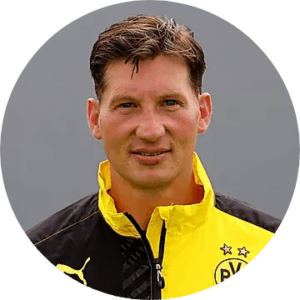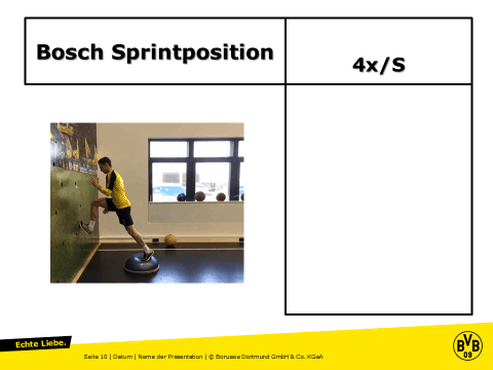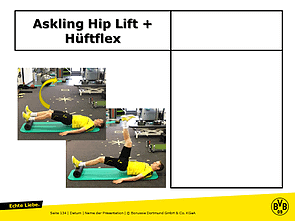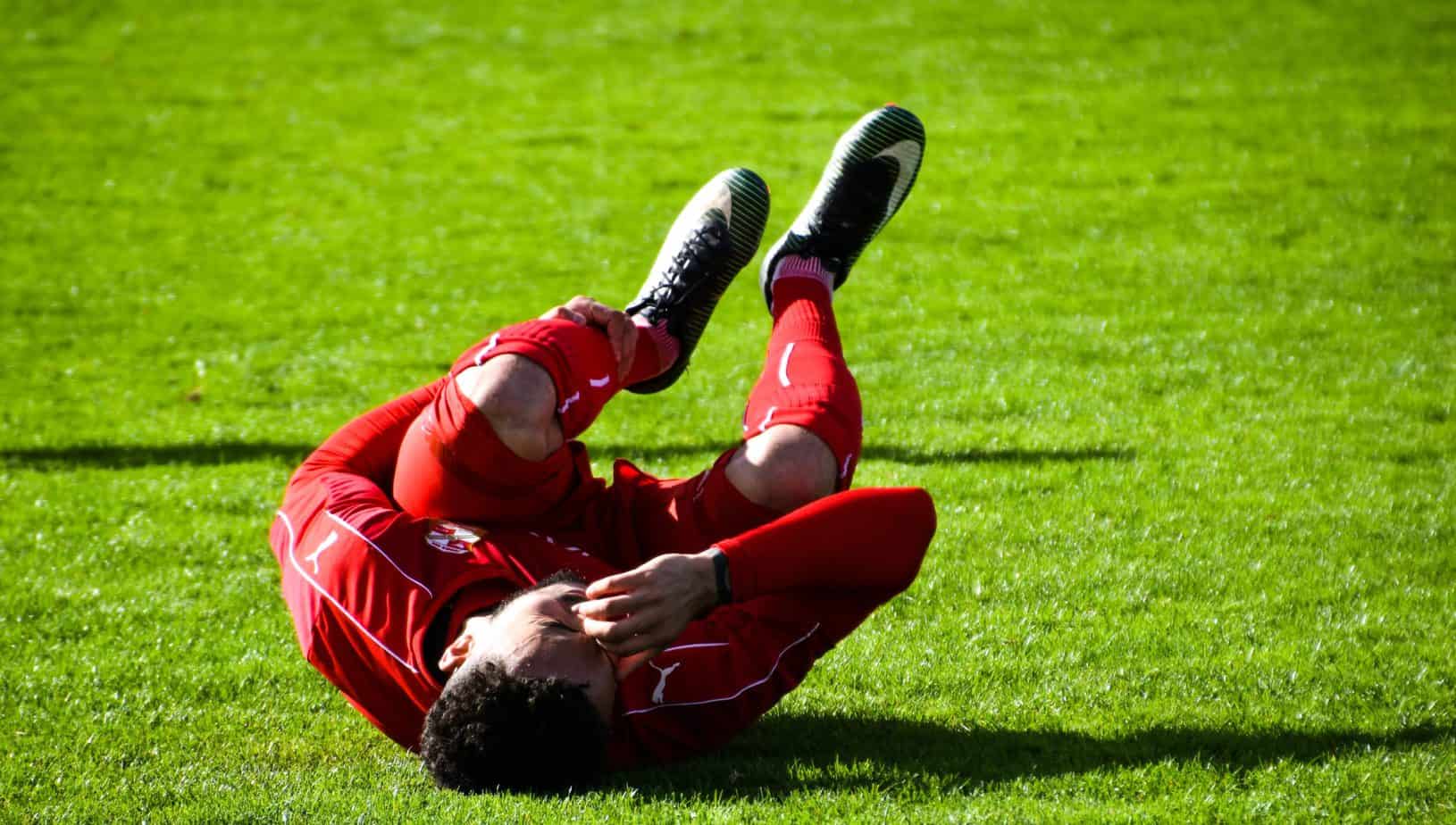Head of Strength & Conditioning at Borussia Dortmund Andreas Beck shares how he prevents and manages hamstring injuries.



By Antonio Robustelli & Andreas Beck
24th April 2018 | 4 min read
Original article by Antonio Robustelli: https://www.omni-athlete.com/post/hamstring-part-5-andreas-beck
Contents of Blog Post
- Introduction to Andreas
- A comprehensive performance program
- Return to play protocol
- Speed training
- Eccentric training
- In-season monitoring
- Weight-bearing and non-weight-bearing training
- About the Authors
- Comments

Introduction to Andreas
AR: Andreas, thank you for being part of this hamstring management series. Can you explain how your role has evolved over time and how you actually manage all the aspects related to performance and rehab at Borussia Dortmund?
Andreas Beck: I’m working in professional football since 2007. Before that, I studied sports science and sports medicine in Frankfurt am Main. While studying, I worked in the fitness industry as a coach: I had my own business as a personal trainer and provided performance diagnostics for clubs. I also worked as a rehab specialist in a physiotherapy facility.
My original goal at that time was to stay at the University to get my PhD and doing more training-related research. Then I got an offer from a football club to join them as an S&C Coach in 2007. For five years I did all the jobs alone: gym work, data collection, individual conditioning, and field-based work with the team. Even testing and education for the Academy. This was all before I had a family.
I was allowed to do all the mistakes which nowadays would lead to being fired. There was no money, no fancy equipment and no high expectations for my position: I could be creative and try out a lot of ideas and evolve as a person as well as a coach.
When Borussia Dortmund offered me a job I had no doubt for me that this was the next necessary step in my career. I joined a team of three coaches and Dr Andreas Schlumberger, currently Head of Medicine at Borussia Mönchengladbach, was the head of our Department. I did a lot of field-based work with the team, I travelled with them and I worked on an individual basis too.
From time to time I did some rehabilitation work, which was the field of expertise of Dr Schlumberger. When Schlumberger left the club together with the head coach (Jurgen Klopp), the new Head Coach Thomas Tuchel brought an S&C coach with him who became the head of S&C: he started doing all the field-based work then I switched my main duties toward rehab and individual training for two years.
Starting in summer 2017, I served as the Head of S&C; I’m now working under my 8th head coach, I have worked in both First and Second Division, I went multiple times with the team to the Cup final and we played Champions and Europa League with the climax in the UCL Final in London 2013.
In my current role besides the work as an S&C coach, I collect as much information as possible: medical data, GPS tracking, well-being data, and game minutes in order to generate a holistic overview of the team and players to help the Head Coach to make smarter decisions. Overall control of training load and effective management of the training week are my main focus in preventing musculoskeletal injuries.
A comprehensive performance program
AR: Hamstrings injury still seems to have a large impact on football players. Do you think there is still the need to emphasise hamstrings training over a more comprehensive performance program? What is your approach in pre-season and during the season?
Andreas Beck: I do not think so, but a comprehensive program should have a focus on hamstring health. The program should have the goal to build robust and resilient players. In my opinion, the management of workload has the most important impact on hamstring injury prevention: we include eccentric and isometric hamstring exercises for the whole team throughout the season.
During pre-season, we start with lower-intensity bodyweight hamstring exercises into the warm-up then progress to added-weight exercises in strength/corrective sessions on a regular basis to create a habit (repeated bout effect).
These exercises are programmed along with more general posterior chain work (unilateral and bilateral).
This is the general idea but all our performance programs and individual plans depend on the context: how is the training and game schedule? There is the possibility of implementing exercises with the necessary protective intensity? Is the player compliant?
Return to play protocol
AR: Most performance and rehab professionals don’t make a proper distinction between training for hamstrings health and training for hamstrings rehab. The different situation in muscle physiology between a previously injured and a non-injured athlete leads to different methods and training variables. How do you manage the rehab process and what baseline testing and metrics you use for return-to-play decisions?
Andreas Beck: Hamstrings are a self-limiting muscle group. The RTP Protocol is player-led and it consists of different phases.
Phase 1 is passed by performing certain exit criteria completely symptom-free.
For running (Phase 2) the player should present the following:
– no ADL problems
– no pain on stretching and contraction tests
– proficiency in jumping with proper push-off and landing over a 40cm square
In our athlete database, we store data which help us with the RTP decision (jump heights, MAS, vmax, MVC). At the end of the RTP process (Phase 4) the player has to demonstrate for example 95% of his vmax to enter Team training.
Speed training
AR: An holistic approach to hamstrings training seems to be supported by some recent research as well as what we see in daily practice. How important is proper speed and coordination training in the hamstrings conditioning process?
Andreas Beck: In my opinion, it is very important. Besides the fact that smart and good training should build robust and resilient players, in a holistic view it is worth focusing on high-speed running since this is one of the situations where a lot of hamstring injuries happen.
In our programs we try to target this through overspeed running with a long tube: the player accelerates over a 35 m distance by letting himself pull in from the tube. He is instructed to follow the tube and make the run look like 100% while it feels like 80%. At the end of the drill, the player will have performed 5-8 steps at maximum velocity. He is instructed not to brake all of a sudden and he should achieve 95% of his maximum speed. Then we use GPS to see if the player hit its personal maximal velocity.
We use overspeed running with the tube as it allows the player to run at 100 % while feeling like 80 %: this gives us the opportunity to focus on movement, positioning, joint velocities etc.
This exercise occurs in the part of the session where isometric, concentric and particular eccentric exercises in knee and hip-dominant versions are also performed.
Eccentric training
AR: Eccentric strength and fascicle length are two fundamental parameters related to the risk of hamstrings injuries. Nordic exercise as well as flywheel eccentric can have their place in a training plan but overemphasising a single exercise or method is a big problem in professional sport. What is your opinion about the way eccentric exercises are being used today?
Andreas Beck: In my opinion, eccentrics stands for a group of exercises where the load is lowered in a controlled manner. There is no prescribed intensity. It is supramaximal or just a breakdown of a given load til it is stopped with an isometric contraction like in flywheel training. The adaptations will differ depending on the intensity at which the exercise is performed.
I don’t know how other teams are implementing eccentric exercises in their routine but I think it is always context-specific: can players handle the initial DOMS? Since adaptations (both mechanical and neural) get lost if you don’t keep doing the exercises on a regular basis, it is essential to find a place in the weekly training schedule. Are the players compliant and motivated enough to force themselves to train with a sufficient intensity?

In-season monitoring
AR: Technology application is growing today and professional teams are starting to invest in high-end equipment to best assist the health of the players. Neuromuscular diagnostics systems as well as eccentric strength asymmetry testing are growing in popularity both in USA and Europe. What is your approach to monitoring hamstrings condition during the season?
Andreas Beck: In my opinion, the most important element is a regular physio check. We also group together the players who are at high risk of a hamstring injury: these are pre-injured players, relatively fast players and those who demonstrate asymmetries and we monitor them very closely.
I believe in personal relationships so I’m trying to talk as much as possible with the players. Diagnostic systems are nice to have but you need to use them; I`ve seen a lot of devices bought by clubs just to demonstrate that they are up to date. The good thing about those systems is that they are motivating because players like numbers so they can help to motivate players to train at the expected intensity.
Weight-bearing and non-weight-bearing training
AR: The last topic I want to address is the difference between weight-bearing and non-weight-bearing exercises for hamstrings function. Muscle activation as well as timing and coordination are highly influenced by foot strike dynamics and overall foot/ankle function: what is your opinion about the ratio between weigh-bearing and non-weight-bearing hamstrings exercises in a specific training program?
Andreas Beck: I think the ratio in our program is about 1:1. Our exercise selection is driven by what we think is necessary and what we think can be as much effective as possible in terms of prevention, strength development and individual needs. We start with a circuit in the gym with the first session of the week where we are going to address stability, mobility and coordination: about 16 exercises are performed for one or two rounds (10-17 min duration).
An example of a non-weight-bearing or open chain exercise regarding hamstring function and their agonists is what we call the “Askling Hip lift + Hüftflex”; it is a single leg bridge on a foam roller with complete hip extension and slight knee flexion. The contralateral leg is straight and is performing a rapid hip flexion like in the Askling H-Test.
An example of a weight-bearing exercise where we target some intermuscular coordination would be our “Bosch Sprintposition” exercise; here we ask the player to take a quick step over a Bosu ball and to catch himself with the other leg on the wall in an optimal sprint position. The player is instructed to be stiff in the ankle and transfer the power through the whole body while just staying on the front of his foot.
We expect that the instability of the Bosu ball forces the ankle with a feed-forward mechanism to activate the stabilisers before the contact. Since we consider ankle, hip and pelvis positions to be very important in a hamstring injury prevention program, this is an exercise where we target the coordination of the leg axis on a low-intensity level.





